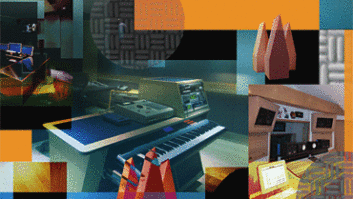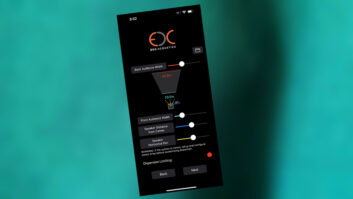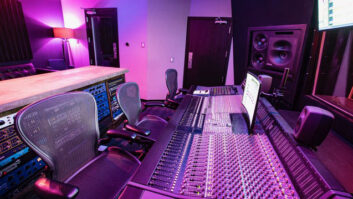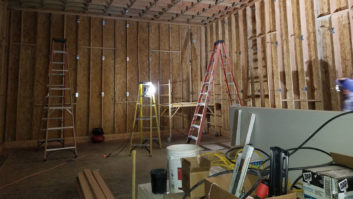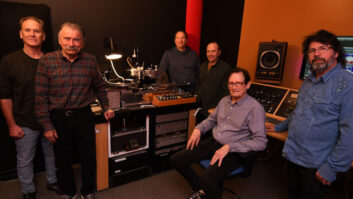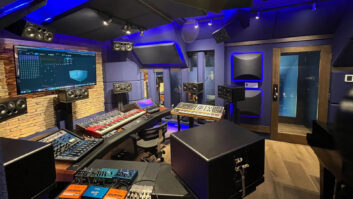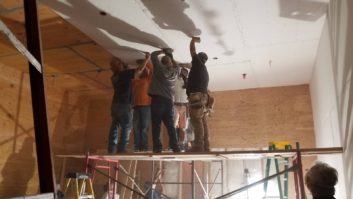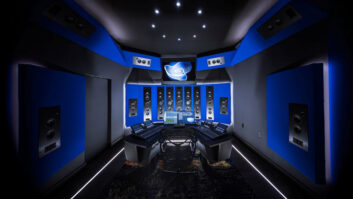These top designers had more to say about treating specific problems for any room—be it a project studio or a multi-million-dollar recording compound. Read on to get more sage advice from these room designers.
George Hallowell
One of the most common and avoidable problems is the placement of near-field monitors horizontally on the bridge of the console,. It creates a reflection off the hard console surface that mixes with the direct signal from the speaker in the first few milliseconds, whereas research has shown that the time between the direct signal and the first reflections should be about 20 milliseconds. Moving the speakers onto speaker stands away from the engineer often improves the sound. And orienting the speakers vertically minimizes time-delay differences between tweeter and woofer as the engineer moves side to side. Also, the speaker-boundary effect between near-field monitors and the control room walls is often ignored, even though there are easily available software modelers, such as the RPG Optimizer, for predicting this effect.
The location and type of mic and instrumentation used in the studio will change the perception of the room acoustics. But use of the room over an extended period will begin to expose any problems of flutter echo, mode buildup or uneven frequency response in certain areas that were not obvious at first.
The ITU-R standards for multichannel sound systems call for placing surrounds at 110 degrees off the room axis, which coincidentally is a position often used for the door in stereo control rooms. A number of new commercial rooms are instead electing to place the surround monitors in the rear corners of the control room, making a sort of ‘X’ pattern with the front-left and -right speakers. In a large control room, that may require compensation for time delay in the distance from the listening position.
Chris Pelonis
An issue I run into is that people have their speakers soffited either improperly or in the wrong place. Relocating the speakers to reduce boundary interference can make a huge difference. There’s also an old style of soffiting that you really need to be aware of: The speaker soffits that kind of hang into the room and beneath them, there’s an airspace. That setup may as well not be soffited. The purpose of soffits is to eliminate boundary interference: When a speaker is mounted flat into a wall, low-frequency energy is forced forward in time, whereas when the speakers are free-standing, omnidirectional energy rebounds off of the front wall and reaches the listener after the initial signal, causing phase distortion. So if you build soffits that are sticking out of the wall with an alcove underneath, not only does it create a cavernous low-frequency resonator, for lack of a better term, it also gives that low frequency a place to go rather than forward.
Richard Schrag
Studios moving more into digital must now allow for the reality of nearly constant upgrading and change. That means hardware systems and wire interconnect systems must be flexible. It puts a tremendous burden on the wire management system as well as on the power and grounding system. Facility design should foresee the kinds of changes that digital audio systems represent, to avoid big surprises down the road. If a facility requires massive renovation to accommodate new technology, it can be devastating to the bottom line.
Carl Yanchar
That’s one of the decisions the client has to make: What their primary market is. For music, the preference is to have the five primary speakers equidistant from the mixer, like it was in Quad. In fact, some people don’t really use the center speaker, so it’s very much like Quad. Whereas in film and TV, there is the so-called ITU standard, where the surround speakers are basically 110 degrees, so they’re closer to the side of you than behind you, which, obviously, doesn’t work too well for music. Because of the different standards, it’s difficult to build something that’s truly multipurpose without compromising one or the other. Often, they don’t use the same type of speakers because you probably want to use matched full-range speakers for music; and in film and TV, the surrounds are sometimes just smaller subsets of the same series. Sometimes not even that. There are even some places that are putting in multiple surround speakers so they can switch back and forth to accommodate both situations.
Related Articles
Acoustic MAKEOVERS
Jun 1, 2000 12:00 PM, Philip De Lancie
The vast array of tools now available for recording, editing, processing and otherwise manipulating sound shows how far the applied science of audio-particularly…
SPEAKER SETUP AND ACOUSTIC TIPS FOR THE FINANCIALLY CHALLENGED
Feb 1, 1999 12:00 PM, Bob Hodas
When Mix asked me to write an article on acoustic fixes for small home studios, I said, “No problem, I’ve analyzed plenty of small rooms.” Then they asked…
Studio Wiring Options
Jun 1, 1999 12:00 PM, Philip De Lancie
If audio signals are the lifeblood of an audio production facility, then wiring is the circulatory system through which those signals move. Once installed,…
Acoustic Makeovers
Jun 1, 2003 12:00 PM, By Chris Michie
Every year, at least 10 recently completed studios or mixing rooms appear on Mix‘s front cover; up to two dozen more are displayed in our annual “Class of…” feature (see page 30)….
Sound Absorbing Material – A Quick Guide
May 31, 2004 11:19 AM
